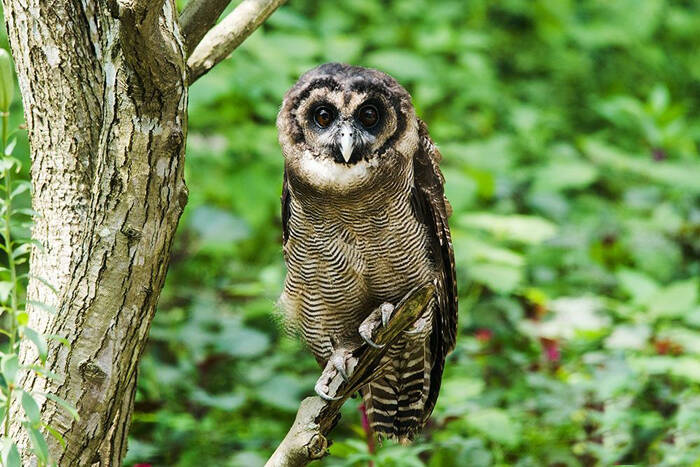Strix leptogrammica
IUCN
LCBasic Information
Scientific classification
- name:Strix leptogrammica
- Scientific Name:Strix leptogrammica,Brown Wood-owl,Brown Wood Owl
- Outline:Raptor
- Family:Strigiformes Owl
Vital signs
- length:46-53cm
- Weight:710-1000g
- lifetime:About 10-20 years
Feature
The head is round, without ear tufts, and the facial disk is prominent, brown or brown-white.
Distribution and Habitat
Distributed in Bangladesh, Bhutan, Brunei, Cambodia, China, India, Indonesia, Lao People's Democratic Republic, Malaysia, Myanmar, Nepal, Sri Lanka, Thailand, Vietnam.
It inhabits mountain forests, coastal areas of tropical forests, plains and low mountain areas. The activity altitude is between sea level and 500 meters above sea level. It is a resident bird in subtropical mountain forests.
Appearance
The head is round, without ear tufts, the face plate is prominent, brown or brown-white, the eye circles are black, and there are white or brown-white eyebrow lines. The top of the head is pure brown, without spots or horizontal spots, the whole body is chestnut brown, and there are white horizontal spots on the shoulders, wings and tail coverts. The throat is white, and the rest of the lower body is yellow with fine brown horizontal spots. The iris is dark brown; the corners of the mouth are brown, the tip corners are yellow, the exposed parts of the toes and the bottoms of the toes are orange, the tips of the claws are yellow, and the tips are darker.
Size measurements: weight ♂750-818g, ♀710-1000g; body length ♂460-503mm, ♀500-530mm; bill peak ♂43-46mm, ♀40-46mm; wings ♂358-400mm , ♀370-407 mm; tail ♂202-235 mm, ♀231-254 mm; tarsometatarsal ♂65 mm, ♀68 mm. (Note: ♂ male; ♀ female)
Details
Brown Wood-owl, also known as Brown Wood-owl in English, is a medium-sized bird of prey with 15 subspecies.

The Brown Wood Owl is a nocturnal owl that often moves in pairs or alone. It hides in dense forests during the day, perching motionlessly and upright on thick branches close to tree trunks with dense branches and leaves. It only comes out to move and hunt at dusk and at night, and sometimes comes out in the dark daytime and deep in the woods. They are alert and timid, and will fly away quickly at the slightest sound. When disturbed during the day, their feathers shrink like a piece of rotten wood, and their eyes half open to observe the movement. Before coming out to hunt at dusk, the mates make appointments with each other by calling. They can make various sounds similar to howling, trembling, screaming and giggling. They mainly feed on rodents, and also eat small birds, frogs, small mammals and insects, and occasionally prey on fish in the water. The main hunting method is to wait on the branches, and when the prey appears, they suddenly pounce on the prey by sneaking.
The breeding season of the brown wood owl is from March to May. They mainly nest in tree holes, and sometimes in caves on rock walls. Usually, two eggs are laid in each nest, and occasionally one. The size of the eggs is 49-58 mm × 41-49 mm. Information such as the incubation period, the period of leaving the nest, and the care of the chicks is unknown. Parent birds are extremely protective of their nests during the incubation and brooding period, and are extremely ferocious, often violently attacking intruders.
Listed in the 2012 Red List of Endangered Species of the World Conservation Union (IUCN) ver 3.1 - Least Concern (LC).
Listed in the second level of the List of National Key Protected Wildlife in China.
Protect wildlife and eliminate game.
Maintaining ecological balance is everyone's responsibility!








